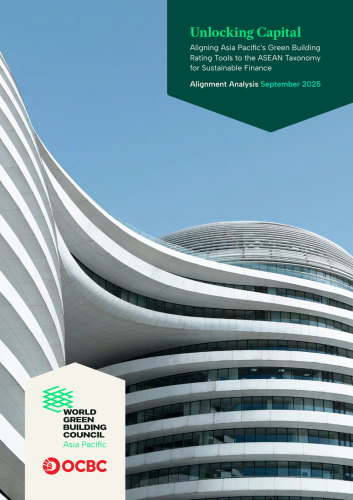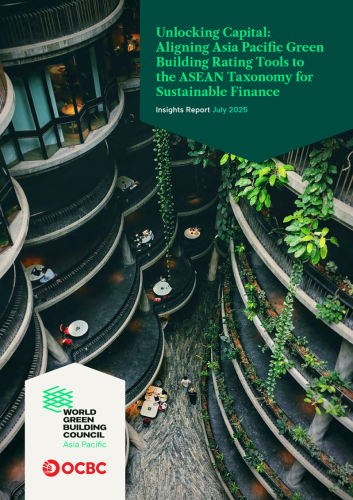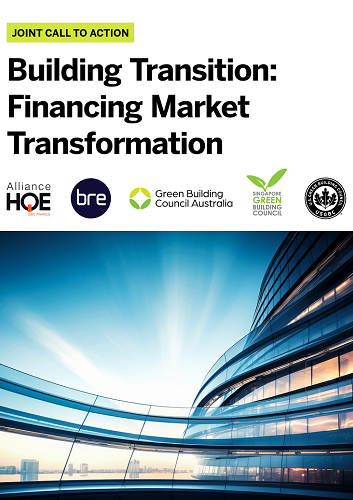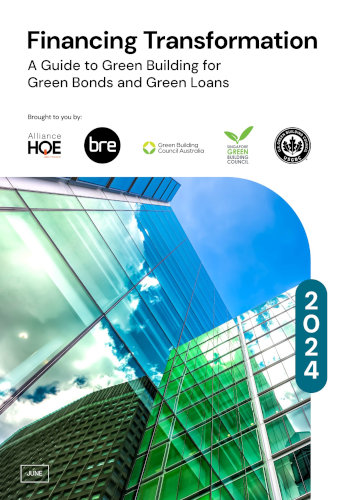Green & Sustainable Finance
A ground-breaking new report and technical appendix, Unlocking Capital: Aligning Asia Pacific’s Green Building Rating Tools to the ASEAN Taxonomy for Sustainable Finance, provides the first focused analysis of how green building certification systems align with sustainable finance principles and the ASEAN Taxonomy’s environmental objectives (technical screening criteria and do no significant harm criteria). The report goes deeper than any before offering a credit-by-credit analysis of 32 rating tools across 16 schemes, covering all of Asia Pacific and beyond.
Developed by the World Green Building Council’s (WorldGBC) Asia Pacific Regional Network (APN) and OCBC, this report fills a critical knowledge gap between technical building performance and investor expectations.
The comprehensive technical appendix offers an unprecedented level of transparency and granularity, mapping each tool’s criteria, credit by credit, against the ASEAN Taxonomy’s Technical Screening Criteria and “Do No Significant Harm” principles. This detailed alignment provides stakeholders with exceptional visibility into how the built environment can meet sustainable finance expectations. As such, the appendix serves as an un-paralleled and invaluable resource for stakeholders across geographies seeking to advance green buildings and mobilise capital for the transition.
Led by the World Green Building Council (WorldGBC), with strong support from SGBC Member OCBC and Asia Pacific green building councils including SGBC, Unlocking Capital: Aligning Asia Pacific Green Building Rating Tools to the ASEAN Taxonomy for Sustainable Finance offers a concise yet strategic overview of the current state of readiness across the sector, presenting key messages and early observations drawn from multi-stakeholder engagement, regional data, and global trends.
The paper highlights the urgent need for systemic change in how we design, build, use, and recover building materials — and identifies the policy, industry, and financial levers that can help accelerate this transition. Together, the three-part publication suite will form a common reference point for policymakers and market actors — supporting more coherent action, investment alignment, and measurable progress across the built environment sector.
Specifically, the Report serves a threefold purpose:
- Framing the urgency – It outlines why the building and construction sector must shift away from today’s linear consumption model, and how this shift aligns with climate targets, economic resilience, and resource security.
- Opportunities for progress are identified in climate adaptation, biodiversity safeguards, embodied carbon, and ongoing performance tracking — priority areas for future iteration.
- Setting the stage – It introduces the broader framework that will be detailed in the next two publications, helping stakeholders anticipate and prepare for more technical guidance to come.
The “Building Transition: How to Scale and Finance an Inclusive Transition for the Built Environment” report released on 13 Nov. 2024 focuses on the 75% of lower-performing buildings that have not yet adopted green building practices.
The initiative, led by the UK’s Building Research Establishment (BRE), the Green Building Council of Australia (GBCA), the Singapore Green Building Council (SGBC), the U.S. Green Building Council (USGBC), and Alliance HQE-GBC France, seeks to close the gap between top performers and the rest of the market.
With the building sector accounting for a significant share of global emissions, unlocking investments for the underperforming majority is seen as a crucial step in decarbonising at scale. This call to action lays out how to attract capital to this large untapped segment, ensuring that decarbonisation happens across the entire built environment – not just in the elite tier of buildings.
The new call to action builds on the earlier report (found below), “Financing Transformation: A Guide to Green Building for Green Bonds and Green Loans” which outlined how green building certifications – such as LEED, BREEAM, Green Star, Green Mark, and HQE – can set the benchmark for sustainable investments. This new report expands the conversation to ensure that financing solutions are inclusive, enabling more building owners to access the funds needed to make meaningful improvements.
The Financing Transformation: A Guide to Green Building for Green Bonds and Green Loans publication was launched by an international alliance of world leading green building rating system organisations as the first global practical guide to facilitate the $35 trillion investment needed by 2030 to meet global energy transition goals.
The publication details how various building verification and certification standards can be used to comply with global classifications and bond frameworks, setting a trajectory for the global built environment to meet a sustainable 1.5°C climate threshold.
This guide is designed to assist institutional investors and financial institutions in effectively integrating green building certifications into financial instruments, empowering them to make informed investment decisions that align with sustainability goals. It also serves as a valuable resource for owners and developers of green buildings seeking new capital sources, offering insights on how to align their projects with green finance requirements.




